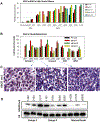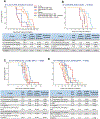Evaluation of an EZH2 inhibitor in patient-derived orthotopic xenograft models of pediatric brain tumors alone and in combination with chemo- and radiation therapies
- PMID: 34802040
- PMCID: PMC10228180
- DOI: 10.1038/s41374-021-00700-8
Evaluation of an EZH2 inhibitor in patient-derived orthotopic xenograft models of pediatric brain tumors alone and in combination with chemo- and radiation therapies
Abstract
Brain tumors are the leading cause of cancer-related death in children. Tazemetostat is an FDA-approved enhancer of zeste homolog (EZH2) inhibitor. To determine its role in difficult-to-treat pediatric brain tumors, we examined EZH2 levels in a panel of 22 PDOX models and confirmed EZH2 mRNA over-expression in 9 GBM (34.6 ± 12.7-fold) and 11 medulloblastoma models (6.2 ± 1.7 in group 3, 6.0 ± 2.4 in group 4) accompanied by elevated H3K27me3 expression. Therapeutic efficacy was evaluated in 4 models (1 GBM, 2 medulloblastomas and 1 ATRT) via systematically administered tazemetostat (250 and 400 mg/kg, gavaged, twice daily) alone and in combination with cisplatin (5 mg/kg, i.p., twice) and/or radiation (2 Gy/day × 5 days). Compared with the untreated controls, tazemetostat significantly (Pcorrected < 0.05) prolonged survival times in IC-L1115ATRT (101% at 400 mg/kg) and IC-2305GBM (32% at 250 mg/kg, 45% at 400 mg/kg) in a dose-dependent manner. The addition of tazemetostat with radiation was evaluated in 3 models, with only one [IC-1078MB (group 4)] showing a substantial, though not statistically significant, prolongation in survival compared to radiation treatment alone. Combining tazemetostat (250 mg/kg) with cisplatin was not superior to cisplatin alone in any model. Analysis of in vivo drug resistance detected predominance of EZH2-negative cells in the remnant PDOX tumors accompanied by decreased H3K27me2 and H3K27me3 expressions. These data supported the use of tazemetostat in a subset of pediatric brain tumors and suggests that EZH2-negative tumor cells may have caused therapy resistance and should be prioritized for the search of new therapeutic targets.
© 2021. The Author(s), under exclusive licence to United States and Canadian Academy of Pathology.
Figures





Similar articles
-
Initial testing (stage 1) of tazemetostat (EPZ-6438), a novel EZH2 inhibitor, by the Pediatric Preclinical Testing Program.Pediatr Blood Cancer. 2017 Mar;64(3):10.1002/pbc.26218. doi: 10.1002/pbc.26218. Epub 2016 Aug 24. Pediatr Blood Cancer. 2017. PMID: 27555605 Free PMC article.
-
Phase 1 study of tazemetostat in Japanese patients with relapsed or refractory B-cell lymphoma.Cancer Sci. 2021 Mar;112(3):1123-1131. doi: 10.1111/cas.14822. Epub 2021 Feb 15. Cancer Sci. 2021. PMID: 33492746 Free PMC article. Clinical Trial.
-
Pharmacology and pharmacokinetics of tazemetostat.Cancer Chemother Pharmacol. 2024 May;93(5):509-517. doi: 10.1007/s00280-024-04658-4. Epub 2024 Mar 23. Cancer Chemother Pharmacol. 2024. PMID: 38520556 Free PMC article. Review.
-
Phase II study of tazemetostat for relapsed or refractory B-cell non-Hodgkin lymphoma with EZH2 mutation in Japan.Cancer Sci. 2021 Sep;112(9):3627-3635. doi: 10.1111/cas.15040. Epub 2021 Jul 14. Cancer Sci. 2021. PMID: 34159682 Free PMC article. Clinical Trial.
-
Tazemetostat for advanced epithelioid sarcoma: current status and future perspectives.Future Oncol. 2021 Apr;17(10):1253-1263. doi: 10.2217/fon-2020-0781. Epub 2020 Dec 8. Future Oncol. 2021. PMID: 33289402 Review.
Cited by
-
Patient-Derived Models of Cancer in the NCI PDMC Consortium: Selection, Pitfalls, and Practical Recommendations.Cancers (Basel). 2024 Jan 29;16(3):565. doi: 10.3390/cancers16030565. Cancers (Basel). 2024. PMID: 38339316 Free PMC article. Review.
-
CD57 defines a novel cancer stem cell that drive invasion of diffuse pediatric-type high grade gliomas.Br J Cancer. 2024 Jul;131(2):258-270. doi: 10.1038/s41416-024-02724-5. Epub 2024 Jun 4. Br J Cancer. 2024. PMID: 38834745 Free PMC article.
-
EZH2 inhibition sensitizes MYC-high medulloblastoma cancers to PARP inhibition by regulating NUPR1-mediated DNA repair.Oncogene. 2025 Feb;44(6):391-405. doi: 10.1038/s41388-024-03232-9. Epub 2024 Nov 19. Oncogene. 2025. PMID: 39562655
-
Roles of Chromatin Remodelling and Molecular Heterogeneity in Therapy Resistance in Glioblastoma.Cancers (Basel). 2022 Oct 9;14(19):4942. doi: 10.3390/cancers14194942. Cancers (Basel). 2022. PMID: 36230865 Free PMC article. Review.
-
Aberrant histone modifications in pediatric brain tumors.Front Oncol. 2025 Jun 10;15:1587157. doi: 10.3389/fonc.2025.1587157. eCollection 2025. Front Oncol. 2025. PMID: 40556679 Free PMC article. Review.
References
-
- Ramaswamy V & Taylor MD Medulloblastoma: from myth to molecular. J. Clin. Oncol 35, 2355–2363 (2017). - PubMed
Publication types
MeSH terms
Substances
Grants and funding
LinkOut - more resources
Full Text Sources
Medical

